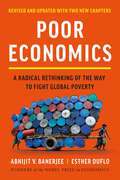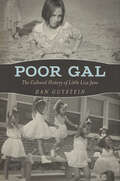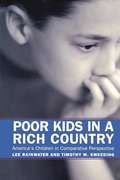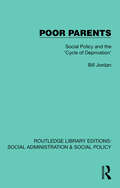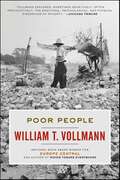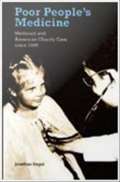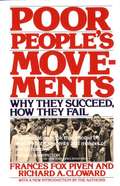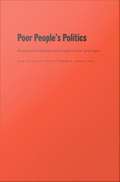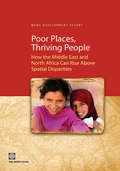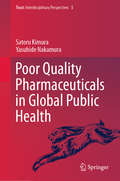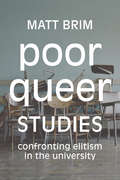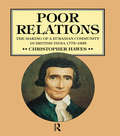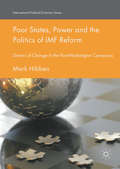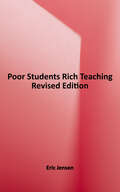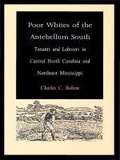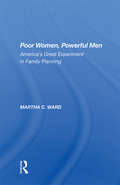- Table View
- List View
Poor Economics: A Radical Rethinking of the Way to Fight Global Poverty
by Esther Duflo Abhijit V. BanerjeeThe winners of the Nobel Prize in Economics upend the most common assumptions about how economics works in this gripping and disruptive portrait of how poor people actually live. Why do the poor borrow to save? Why do they miss out on free life-saving immunizations, but pay for unnecessary drugs? In Poor Economics, Abhijit V. Banerjee and Esther Duflo, two award-winning MIT professors, answer these questions based on years of field research from around the world. Called "marvelous, rewarding" by the Wall Street Journal, the book offers a radical rethinking of the economics of poverty and an intimate view of life on 99 cents a day. Poor Economics shows that creating a world without poverty begins with understanding the daily decisions facing the poor.
Poor Gal: The Cultural History of Little Liza Jane (American Made Music Series)
by Dan GutsteinPoor Gal: The Cultural History of Little Liza Jane chronicles the origins and evolution of a folk tune beloved by millions worldwide. Dan Gutstein delves into the trajectory of the “Liza Jane” family of songs, including the most popular variant “Li’l Liza Jane.” Likely originating among enslaved people on southern plantations, the songs are still performed and recorded centuries later.Evidence for these tunes as part of the repertoire of enslaved people comes from the Works Progress Administration ex-slave narratives that detail a range of lyrics and performance rituals related to “Liza Jane.” Civil War soldiers and minstrel troupes eventually adopted certain variants, including “Goodbye Liza Jane.” This version of the song prospered in the racist environment of burnt cork minstrelsy. Other familiar variants, such as “Little Liza Jane,” likely remained fixed in folk tradition until early twentieth-century sheet music popularized the melody.New genres and a slate of stellar performers broadly adopted these folk songs, bringing the tunes to far-reaching listeners. In 1960, to an audience of more than thirty million viewers, Harry Belafonte performed “Little Liza Jane” on CBS. The song was featured on such popular radio shows as Fibber McGee & Molly; films such as Coquette; and a Mickey Mouse animation. Hundreds of recognizable performers—including Fats Domino, Bing Crosby, Nina Simone, Mississippi John Hurt, and Pete Seeger—embraced the “Liza Jane” family. David Bowie even released “Liza Jane” as his first single. Gutstein documents these famous renditions, as well as lesser-known characters integral to the song’s history. Drawing upon a host of cultural insights from experts—including Eileen Southern, Carl Sandburg, Thomas Talley, LeRoi Jones/Amiri Baraka, Charles Wolfe, Langston Hughes, and Alan Lomax—Gutstein charts the cross-cultural implications of a voyage unlike any other in the history of American folk music.
Poor Kids In A Rich Country: America's Children In Comparative Perspective
by Lee Rainwater Timothy M. SmeedingIn comparing the situation of American children in low-income families with their counterparts in other wealthy countries, Lee Rainwater and Timothy M. Smeeding provide a powerful perspective on the dynamics of child poverty in the United States.
Poor Parents: Social Policy and the 'Cycle of Deprivation' (Routledge Library Editions: Social Administration & Social Policy)
by Bill JordanOriginally published in 1974, this book provides a critique of official policy towards families with young children living on low incomes and looks in detail at some of the myths prevalent in the public debate – both political and academic – about the ‘cycle of deprivation’, a phrase coined by Sir Keith Joseph (British Politician, 1918-1994). One of these myths is that it is possible to provide, on a selective basis, the best services for the poorest members of the community. Anthe is that the poorest group is the one which is in most need of every kind of social service. A third is that the more generous provision of social services to areas with high concentrations of poor families can reduce tensions and conflicts between social groups. The author contends that these myths are being used to obscure the fact that the persistent force behind post-war social policy is none other than the spirit of the Poor Law.
Poor People
by William T. VollmannThat was the simple yet groundbreaking question William T. Vollmann asked in cities and villages around the globe. The result of Vollmann's fearless inquiry is a view of poverty unlike any previously offered.Poor People struggles to confront poverty in all its hopelessness and brutality, its pride and abject fear, its fierce misery and quiet resignation, allowing the poor to explain the causes and consequences of their impoverishment in their own cultural, social, and religious terms. With intense compassion and a scrupulously unpatronizing eye, Vollmann invites his readers to recognize in our fellow human beings their full dignity, fallibility, pride, and pain, and the power of their hard-fought resilience.Some images that appeared in the print edition of this book are unavailable in the electronic edition due to rights reasons.
Poor People's Medicine: Medicaid and American Charity Care Since 1965
by Jonathan EngelPoor People's Medicine is a detailed history of Medicaid since its beginning in 1965. Federally aided and state-operated, Medicaid is the single most important source of medical care for the poorest citizens of the United States. From acute hospitalization to long-term nursing-home care, the nation's Medicaid programs pay virtually the entire cost of physician treatment, medical equipment, and prescription pharmaceuticals for the millions of Americans who fall within government-mandated eligibility guidelines. The product of four decades of contention over the role of government in the provision of health care, some of today's Medicaid programs are equal to private health plans in offering coordinated, high-quality medical care, while others offer little more than bare-bones coverage to their impoverished beneficiaries. Starting with a brief overview of the history of charity medical care, Jonathan Engel presents the debates surrounding Medicaid's creation and the compromises struck to allow federal funding of the nascent programs. He traces the development of Medicaid through the decades, as various states attempted to both enlarge the programs and more finely tailor them to their intended targets. At the same time, he describes how these new programs affected existing institutions and initiatives such as public hospitals, community clinics, and private pro bono clinical efforts. Along the way, Engel recounts the many political battles waged over Medicaid, particularly in relation to larger discussions about comprehensive health care and social welfare reform. Poor People's Medicine is an invaluable resource for understanding the evolution and present state of programs to deliver health care to America's poor.
Poor People's Movements: Why They Succeed, How They Fail
by Frances F. Piven Richard A. ClowardHave the poor fared best by participating in conventional electoral politics or by engaging in mass defiance and disruption? The authors of the classic Regulating The Poor assess the successes and failures of these two strategies as they examine, in this provocative study, four protest movements of lower-class groups in 20th century America: -- The mobilization of the unemployed during the Great Depression that gave rise to the Workers' Alliance of America -- The industrial strikes that resulted in the formation of the CIO -- The Southern Civil Rights Movement -- The movement of welfare recipients led by the National Welfare Rights Organization.
Poor People's Politics: Peronist Survival Networks and the Legacy of Evita
by Javier Auyero"Political clientelism" is a term used to characterize the contemporary relationships between political elites and the poor in Latin America in which goods and services are traded for political favors. Javier Auyero critically deploys the notion in Poor People's Politics to analyze the political practices of the Peronist Party among shantytown dwellers in contemporary Argentina. Looking closely at the slum-dwellers' informal problem-solving networks, which are necessary for material survival, and the different meanings of Peronism within these networks, Auyero presents the first ethnography of urban clientelism ever carried out in Argentina. Revealing a deep familiarity with the lives of the urban poor in Villa Paraso, a stigmatized and destitute shantytown of Buenos Aires, Auyero demonstrates the ways in which local politicians present their vital favors to the poor and how the poor perceive and evaluate these favors. Having penetrated the networks, he describes how they are structured, what is traded, and the particular way in which women facilitate these transactions. Moreover, Auyero proposes that the act of granting favors or giving food in return for votes gives the politicians' acts a performative and symbolic meaning that flavors the relation between problem-solver and problem-holder, while also creating quite different versions of contemporary Peronism. Along the way, Auyero is careful to situate the emergence and consolidation of clientelism in historic, cultural, and economic contexts. Poor People's Politics reexamines the relationship between politics and the destitute in Latin America, showing how deeply embedded politics are in the lives of those who do not mobilize in the usual sense of the word but who are far from passive. It will appeal to a wide range of students and scholars of Latin American studies, sociology, anthropology, political science, history, and cultural studies.
Poor Places, Thriving People: How the Middle East and North Africa Can Rise Above Spatial Disparities
by World BankGeographical differences in living standards are a pressing concern for policymakers in the Middle East and North Africa (MENA). Economies of agglomeration mean that production is most efficient when concentrated in leading areas. So how can the region reduce spatial disparities in well-being without compromising growth? The solution to spatial disparities lies in matching the policy package to a lagging area's specific characteristics. Key questions include: is the lagging area problem really as serious as one thinks; is it a problem of low economic opportunity or of poor human development; are lagging area populations close enough to agglomerations to benefit from spillovers; and is there manifest private investor interest? Drawing on the World Bank's 2009 World Development Report, Reshaping Economic Geography, the book proposes 3 policy packages. First, all lagging areas can benefit from a "level playing-field for development" and investment in people. Geographic disparities in the policy environment are a legacy of MENA's history, and gaps in human development are a major component of spatial disparities. Smart policies for the investment environment, health, education, social transfers and urban development can therefore close spatial gaps in living standards. Second, lagging areas that are close to economic agglomeration can benefit from spillovers - provided that they are connected. MENA's expenditure priority is not necessarily long-distance primary connections, but infrastructure maintenance and short-distance connections such as rural roads and peri-urban networks. Public-private partnerships can also bring electronic connectivity to lagging areas. Third, shifting regional development policy away from spatial subsidies towards the facilitation of cluster-based growth will increase the chance of cost-effective impacts. The final chapter of the book examines the institutional prerequisites for effective spatial policy. It argues that MENA's centralized/sectoral structures are not always adapted to governments' spatial development agendas, and describes alternative institutional options.
Poor Quality Pharmaceuticals in Global Public Health (Trust #5)
by Satoru Kimura Yasuhide NakamuraThis book aims to clarify the global aspects of poor quality pharmaceuticals, generic products in particular, becoming complicated through the process of IMPACT (International Medical Products Anti-Counterfeiting Taskforce) organized by the initiative of the World Health Organization (WHO) in 2006. The findings from this book provide a long-term perspective to policymakers. This book discusses from the following points: industrial standardization, healthcare market accessibility, motivation on supply side, WHO medicines policy and intellectual property rights. Standardization regulates the quality and enabled the generic medicines spreading to developing/emerging countries through technology transfer. However, quality is a part of cost and reflected to price. When a healthcare service market is divided according to wealth gap, compliance to standardization for quality on supply side is divided accordingly. Thus, poor quality pharmaceuticals are prevalent worldwide. Generic pharmaceuticals are essential resources in public health. The WHO has been involved in the dispute around the intellectual property rights under its intention to promote the new drug development for neglected diseases. Global pandemic of AIDs is a critical factor to accelerate the confusion. This created feelings of distrust among developing/emerging countries against developed countries if the WHO was in favour of developed countries. In addition to that, an easy and optimistic start of IMPACT stirred up conflicts of interests in the international community. The problem of poor quality pharmaceuticals became more complicated through the conflicts on intellectual property rights; patented drugs to generic drugs. A key for quality generic products is the formation of a single healthcare service market where good motivation on supply side together with fair competitiveness with patented pharmaceuticals and equitable access to services (both for the rich and the poor) are ensured. Political commitment to investment and regulatory infrastructure for the market is crucial.
Poor Queer Studies: Confronting Elitism in the University
by Matt BrimIn Poor Queer Studies Matt Brim shifts queer studies away from its familiar sites of elite education toward poor and working-class people, places, and pedagogies. Brim shows how queer studies also takes place beyond the halls of flagship institutions: in night school; after a three-hour commute; in overflowing classrooms at no-name colleges; with no research budget; without access to decent food; with kids in tow; in a state of homelessness. Drawing on the everyday experiences of teaching and learning queer studies at the College of Staten Island, Brim outlines the ways the field has been driven by the material and intellectual resources of those institutions that neglect and rarely serve poor and minority students. By exploring poor and working-class queer ideas and laying bare the structural and disciplinary mechanisms of inequality that suppress them, Brim jumpstarts a queer-class knowledge project committed to anti-elitist and anti-racist education. Poor Queer Studies is essential for all of those who care about the state of higher education and building a more equitable academy.
Poor Relations: The Making of a Eurasian Community in British India, 1773-1833
by Christopher J. HawesThe sixty years between 1773 and 1833 determined British paramountcy in India. Those years were formative too for British Eurasians. By the 1820s Eurasians were an identifiable and vocal community of significant numbers particularly in the main Presidency towns. They were valuable to the administration of government although barred in the main from higher office. The ambition of their educated elite was to be accepted as British subjects, not to be treated as native Indians, an ambition which was finally rejected in the 1830s.
Poor Richard's Women: Deborah Read Franklin and the Other Women Behind the Founding Father
by Nancy Rubin StuartA vivid portrait of the women who loved, nurtured, and defended America&’s famous scientist and founding father.Everyone knows Benjamin Franklin—the thrifty inventor-statesman of the Revolutionary era—but not about his love life. Poor Richard&’s Women reveals the long-neglected voices of the women Ben loved and lost during his lifelong struggle between passion and prudence. The most prominent among them was Deborah Read Franklin, his common-law wife and partner for forty-four years. Long dismissed by historians, she was an independent, politically savvy woman and devoted wife who raised their children, managed his finances, and fought off angry mobs at gunpoint while he traipsed about England.Weaving detailed historical research with emotional intensity and personal testimony, Nancy Rubin Stuart traces Deborah&’s life and those of Ben&’s other romantic attachments through their personal correspondence. We are introduced to Margaret Stevenson, the widowed landlady who managed Ben&’s life in London; Catherine Ray, the twenty-three-year-old New Englander with whom he traveled overnight and later exchanged passionate letters; Madame Brillon, the beautiful French musician who flirted shamelessly with him, and the witty Madame Helvetius, who befriended the philosophes of pre-Revolutionary France and brought Ben to his knees.What emerges from Stuart&’s pen is a colorful and poignant portrait of women in the age of revolution. Set two centuries before the rise of feminism, Poor Richard&’s Women depicts the feisty, often-forgotten women dear to Ben&’s heart who, despite obstacles, achieved an independence rarely enjoyed by their peers in that era.
Poor States, Power and the Politics of IMF Reform
by Mark HibbenThis books provides a timely comparative case study that reveals the factors driving the International Monetary Fund's policy reform in Low Income Developing Countries (LIDCs), as a resurgent IMF expands its footprint in the world's poorest states. Through a research design that employs both mainstream and critical IPE theory, Mark Hibben uncovers three major tendencies. Principal-agent analysis, he argues, demonstrates that coalition formation among powerful states, IMF staff and management, and other influential actors is necessary for policy reform. At the same time, he uses constructivist analysis to show that ideational frameworks of what merits appropriate macroeconomic policy response also have an impact on reform efforts, and that IMF management and staff seek legitimacy in their policy choices. In response to the crises in 1999 and 2008, the author maintains, poverty and inequality now 'matter' in IMF thinking and serve as an opportunity for policy insiders and external actors to deepen the institution's new commitment to 'inclusive' growth. Finally, Hibben draws on neo-Gramscian analysis to highlight how the IMF looked to soften the destabilizing effects of globalization through reforms focused on stakeholder participation in poor states and will continue to do so in its support of the new United Nation Sustainable Development Goals. This means that the 2015-2030 time period will be a critical juncture for IMF LIDC reform. By drawing from diverse theoretical traditions, the author thus provides a unique framework for the study of contemporary IMF change and how best those interested in LIDC policy reform can meet this objective.
Poor Students, Rich Teaching: Seven High-Impact Mindsets for Students from Poverty (using Mindsets in the Classroom to Overcome Student Poverty and Adversity)
by Eric JensenThere are three critical characteristics to know about poverty and education:- The devastating effects of poverty are accelerating. - Poverty affects both you and your students in multiple adverse ways. - You have the power to reverse the academic impact poverty has on your students, and this comprehensive resource will show you how. In this revised and updated edition, two of Eric Jensen's top-selling books (Poor Students, Rich Teaching and Poor Students, Richer Teaching) have been merged into one must-read resource on poverty and education. Dr. Eric Jensen clearly defines seven mindsets essential for reaching economically disadvantaged students and shares corresponding strategies for overcoming adversity and ensuring college and career readiness for all learners, regardless of socioeconomic status. Motivate students to learn in the face of poverty using mindsets in the classroom: -Understand the urgency of poverty in the United States and how poverty affects education, student engagement, and academic achievement. - Learn how creating a positive school culture and a growth mindset for students can be beneficial in overcoming adversity. - Gain seven high-impact mindsets that bring change: the relational mindset, achievement mindset, rich classroom climate mindset, engagement mindset, positivity mindset, enrichment mindset, and graduation mindset. - Build effective teacher-student relationships, and help students see college and career readiness as a reachable target. - Create a welcoming classroom climate where all students love to learn and drive student engagement, motivation, and success.
Poor Whites of the Antebellum South: Tenants and Laborers in Central North Carolina and Northeast Mississippi
by Charles C. BoltonIn Poor Whites of the Antebellum South, Charles C. Bolton gives a distinct voice to one of the most elusive groups in the society of the Old South. Bolton's detailed examination reveals much about the lives of these landless white tenants and laborers and their relationship to yeoman farmers, black slaves, free blacks and elite whites. Providing a provocative analysis of the failure of the Jeffersonian "yeoman ideal" of democracy in white-majority areas, this book also shows how poor whites represented a more significant presence on the political, economic, and social landscape than previously had been thought.Looking at two specific regions--the "settled" central piedmont of North Carolina and the "frontier" of northeast Mississippi--Bolton describes how poor whites played an important, though circumscribed, role in the local economy. Dependent on temporary employment, they represented a troubling presence in a society based on the principles of white independence and black slavery. Although perceived by southern leaders as a threat, poor whites, Bolton argues, did not form a political alliance with either free or enslaved blacks because of numerous factors including white racism, kinship ties, religion, education, and mobility. A concluding discussion of the crisis of 1860-61 examines the rejection of secession by significant numbers of poor whites, as well as the implications for their future as the Old South turned toward the new.Poor Whites of the Antebellum South sheds light on a group often neglected in southern history. It is an important contribution that will be of interest to all students and historians of the American South.
Poor Women, Powerful Men: America's Great Experiment In Family Planning
by Martha C WardPoor Women, Powerful Men chronicles the achievements and subsequent failure of the Louisiana Family Health Foundation, the most extensive family planning program ever to operate in the United States. Martha C. Ward's even-handed account reveals the mechanisms—of politics, poverty, and public health policies—at work in the perpetual controversies surrounding reproductive rights and the delivery of health care services to the poor. Ward's book begins in the early 1960s when Louisiana was among the most underdeveloped states and ranked at the bottom of all scales measuring illiteracy, illegitimacy, and infant mortality. Despite the free statewide Charity Hospital system, many routine preventive medical and public health services were not available to poor women and their children, particularly if they were black. But in the mid-1960s, a visionary group of doctors and health care practitioners began to clear the hurdles erected by law, church, and the medical-political establishment. By 1970 they had set up the first statewide family planning program for poor people in the United States. The Louisiana experiment was a spectacular success. The Ford, Rockefeller, and Kellogg Foundations poured millions of dollars into the program. The Great Society and War on Poverty programs placed a high priority on the health of poor mothers and infants. With the help of the population lobby—including Planned Parenthood and the Agency for International Development—the Family Health Foundation moved into Latin America and other developing areas. But in 1974, the bubble burst. Accusations of fiscal mismanagement, fraudulent statistics, patronage, and political payoffs led to federal indictments and jail sentences for top officials. Poor women and powerful men, the black and white communities, and the liberal and conservative medical factions were pitted against each other. With the collapse of the program, methods for handling the epidemic of adolescent pregnancies and the high infant mortality rate reverted to the state bureaucracies. Poor Women, Powerful Men is the first book-length account of the Louisiana experiment. In a clear and dispassionate voice, Ward demonstrates that many of the questions raised by the experiment persist. Is family planning an answer to the cycle of poverty, teenage pregnancies, and infant mortality? How can the conflict between private and public delivery of medical care be resolved? Where do the reproductive rights of women fit into governmentally supported birth control programs? We seem no closer today to answering these questions than the Louisiana Family Health Foundation was more than a decade ago.
Poor Worker's Unions: Rebuilding Labor from Below (Completely Revised and Updated Edition)
by Cristina Tzintzún Vanessa TaitA classic account of low-wage workers' organization that the US Department of Labor calls one of the "100 books that has shaped work in America."As low-wage organizing campaigns have been reignited by the Fight for 15 movement and other workplace struggles the classic Poor Workers' Unions-one of the 100 books the US Department of Labor says has "shaped work in America"-is as prescient as ever.
Poor and Homeless in the Sunshine State: Down and Out in Theme Park Nation
by James WrightA place like Orlando, Florida is not transformed from swampland to sprawling metropolis through Peter Pan-like flights of fancy, but through theme park expansions requiring developmental schemes that are tough minded and often worsen relationships between the wealthy and the poor. The homeless arrive with their own hopes and illusions, which are soon shattered. The rest of the local population makes its peace with the system. Meanwhile the homeless are reduced to advocacy models that neither middle- nor working-class folks much worry about. They are modern members of Ellison's "invisible men" but they comprise a racial and social mixture unlike any other in the American landscape.This book is primarily about the dark side of this portrait the poor, near-poor, homeless, and dispossessed who live in the midst of this verdant landscape. The phrase "down and out," has been used to describe people who are destitute or penniless since the late nineteenth century. Here the term is used in a more expansive sense, as synonymous with anyone who lives near, at, or over the edge of financial catastrophe.
Poor and Pregnant in New Delhi, India (International Institute for Qualitative Methodology Series)
by Helen VallianatosIn this innovative contribution to the study of food, gender, and power, Helen Vallianatos meticulously documents cultural values and beliefs, dietary practaices, and the nutritional and health status of mothers in Indian squatter settlements. She explores both large-scale forces—incorporating critical medical anthropology and feminist theory into a biocultural paradigm—and the local and individual choices New Delhi women make in interpreting cultural dietary norms based on their reproductive histories, socioeconomic status, family structure, and other specific conditions. Her findings have significant implications for nutritional and medical anthropology and development studies, and her innovative research design serves as a model for multi-method studies that use participatory research principles, combine quantitative and qualitative investigations, and interpret diverse types of data.
Poor but Sexy: Culture Clashes in Europe East and West
by Agata Pyzik24 years after the fall of the Berlin Wall, Europe is as divided as ever. The passengers of the low-budget airlines go east for stag parties, and they go West for work; but the East stays East, and West stays West. Caricatures abound - the Polish plumber in the tabloids, the New Cold War in the broadsheets and the endless search for "the new Berlin" for hipsters. Against the stereotypes, Agata Pyzik peers behind the curtain to take a look at the secret histories of Eastern Europe (and its tortured relations with the "West"). Neoliberalism and mass migration, post-punk and the Bowiephile obsession with the Eastern Bloc, Orientalism and "self-colonization", the emancipatory potentials of Socialist Realism, the possibility of a non-Western idea of modernity and futurism, and the place of Eastern Europe in any current revival of "the idea of communism" -- all are much more complex and surprising than they appear. Poor But Sexy refuses both a dewy-eyed Ostalgia for the "good old days" and the equally desperate desire to become a "normal part of Europe", reclaiming instead the idea an Other Europe.
Poor: Grit, courage, and the life-changing value of self-belief
by Katriona O'SullivanThe No. 1 BestsellerBiography of the Year, Irish Book Awards 2023The Last Word Listeners' Choice Award, Irish Book Awards 2023'One of the best [books] I have read about the complexities of poverty . . . one of the most remarkable people you will ever meet' GuardianLike young girls everywhere Katriona O’Sullivan grew up bright, enthusiastic, curious. But she was also surrounded by abject poverty and chaos, and after she became pregnant and homeless at 15, what followed was five years of barely surviving. Yet today Katriona is an award-winning academic whose work explores barriers to education for girls like her.What set Katriona on this unexpected path were the mentors and supporters who truly saw her. The teachers who showed her how to wash in the school toilets or turned up at her door to convince her to sit at least one GCSE. The community worker who encouraged her to apply for training schemes. The friend who introduced Katriona to Trinity College’s access program while she was a cleaner. Simple acts that would help her turn her life around.Told with warmth, clarity and compassion – compassion for her parents, for her younger self, for others – Poor is both an astonishing personal testimony and an impassioned plea for the future of our children.‘Powerful – Katriona is a legend’ Barry Keoghan‘Raw, passionate and resolutely honest – I’ll never forget it’ Annie Mac'Full of insight . . . so important' Fi Glover, Times Radio 'I read poor in one sitting I found it so compelling . . . moving, uplifting, brave, heroic' Nuala McGovern, Woman's Hour, BBC Radio Four'Moving, funny, brave and original - just like the author . . . absolutely incredible' Roísín Ingle, Irish Times Women's Podcast‘One of the books of the year’ Patrick Kielty, Late Late Show, RTÉ One'One of the most important books I have ever read … a beautiful telling of determination despite the odds' Lynn Ruane, Irish Times 'Fearless, funny and searingly honest' Adil Ray OBE'Raw and remarkable' Irish Independent 'A book of empowerment and hope' Patricia Scanlan‘Remarkable . . . a vivid retelling of Katriona flourishing, despite her beginnings’ BBC News West MidlandsNumber 1 bestseller, Irish Times, March 2024
Pop Art and Popular Music: Jukebox Modernism (Routledge Research in Art History)
by Melissa L. MednicovThis book offers an innovative and interdisciplinary approach to Pop art scholarship through a recuperation of popular music into art historical understandings of the movement. Jukebox modernism is a procedure by which Pop artists used popular music within their works to disrupt decorous modernism during the sixties. Artists, including Peter Blake, Pauline Boty, James Rosenquist, and Andy Warhol, respond to popular music for reasons such as its emotional connectivity, issues of fandom and identity, and the pleasures and problems of looking and listening to an artwork. When we both look at and listen to Pop art, essential aspects of Pop’s history that have been neglected—its sounds, its women, its queerness, and its black subjects—come into focus.
Pop Art: A Colourful History
by Alastair SookePop Art by the BBC's Alastair Sooke - an essential but snappy new guide to our favourite art movementPop Art is the most important 20th-century art movement. It brought Modernism to the masses, making art sexy and fun with coke cans and comics. Today, in our age of selfies and social networking, we are still living in a world defined by Pop.Full of brand new interviews and research, Sooke describes the great works by Warhol, Lichtenstein and other key figures, but also re-examines the movement for the 21st century and asks if it is still art? He reveals a global story, tracing Pop's surprising origins in 19th-century Paris to uncovering the forgotten female artists of the 1960s."A clear and lively outline of the history of pop art ... a pleasure to read" - Sunday Times
Pop City: Korean Popular Culture and the Selling of Place
by Youjeong OhPop City examines the use of Korean television dramas and K-pop music to promote urban and rural places in South Korea. Building on the phenomenon of Korean pop culture, Youjeong Oh argues that pop culture-featured place selling mediates two separate domains: political decentralization and the globalization of Korean popular culture. The local election system introduced in the mid 90s has stimulated strong desires among city mayors and county and district governors to develop and promote their areas. Riding on the Korean Wave—the overseas popularity of Korean entertainment, also called Hallyu—Korean cities have actively used K-dramas and K-pop idols in advertisements designed to attract foreign tourists to their regions. Hallyu, meanwhile, has turned the Korean entertainment industry into a speculative field into which numerous players venture by attracting cities as sponsors. By analyzing the process of culture-featured place marketing, Pop City shows that urban spaces are produced and sold just like TV dramas and pop idols by promoting spectacular images rather than substantial physical and cultural qualities. Popular culture-associated urban promotion also uses the emotional engagement of its users in advertising urban space, just as pop culture draws on fans’ and audiences’ affective commitments to sell its products. Oh demonstrates how the speculative, image-based, and consumer-exploitive nature of popular culture shapes the commodification of urban space and ultimately argues that pop culture–mediated place promotion entails the domination of urban space by capital in more sophisticated and fetishized ways.
